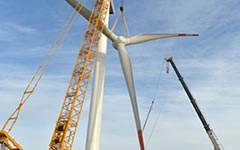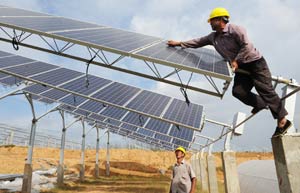New energy a new magnet for Xinjiang investment
Updated: 2014-09-06 15:11
(Xinhua)
|
||||||||
URUMQI - China's Xinjiang Uygur autonomous region, with an abundance of flat, windy expanses and steady sunshine, is becoming a magnet for investors seeking to harness the region's clean energy resources.
This became apparent as investors inked several major energy deals at the fourth China-Eurasia Expo (CEE), a six-day international fair that concluded Saturday in Urumqi, Xinjiang's regional capital.
On Tuesday, Huocheng county of Ili Kazak autonomous prefecture drew a 500-million-yuan photovoltaic project with Zhenfa New Energy, based in the eastern Jiangsu province. The project is expected to be put in production this year.

|
 |
Huocheng is a prime example of the investment scene emerging across Xinjiang. According to official statistics, a total of 23 industrial projects involving clean energy were clinched at the CEE this year, with a total contract value of about 37.7 billion yuan ($6.1 billion), topping the combined investments of traditional projects in coal and coal chemical industries.
In recent years, renewable energy is increasingly a new choice for investors over traditional resources amid China's worsening environmental woes, particularly in Xinjiang, where new energy such as wind and solar are largely available thanks to the region's geological conditions.
Xinjiang is home to nine major wind areas. Its wind energy accounts for 37 percent of the country's total, only second to North China's Inner Mongolia autonomous region. Meanwhile, average daily hours of sunshine in Xinjiang is the second best around the country, allowing for photovoltaic projects to be steered through the wide areas of desert and sand.
Another underlying reason for the new energy fervor at the expo is governmental support, explained Yu Wuming, deputy director with the National Windpower Engineering Technology Research Center.
In 2012, the National Development and Reform Commission put forward a broad-stroke plan for Xinjiang encouraging power generation via renewable energy, which, according to Yu, laid a solid foundation for future projects.
The region's ultra-high voltage power transmission line, which transmits electricity from Xinjiang to the eastern area of China, has also contributed to the growing number of investors in the region.
Xinjiang expects to reach a capacity of 13 million kw of wind power and 3 million kw of photoelectricity by the end of 2014, according to State Grid Xinjiang Electric Power Company.

 Wozniacki reaches US open final as injured Peng quits
Wozniacki reaches US open final as injured Peng quits
 US Chinese to join Mid-Autumn Festival celebrations
US Chinese to join Mid-Autumn Festival celebrations
 Turkey feast honors China-US relations
Turkey feast honors China-US relations
 One year and still soaring
One year and still soaring
 US comedienne Joan Rivers dies at 81
US comedienne Joan Rivers dies at 81
 Bringing precious relics back home
Bringing precious relics back home
 News in review
News in review
 Snoopy celebrates 65th anniversary in Shanghai
Snoopy celebrates 65th anniversary in Shanghai
Most Viewed
Editor's Picks

|

|

|

|

|

|
Today's Top News
Plane with unresponsive pilot crashes off Jamaica
Alibaba to raise $20b in IPO record
Boao Forum meets in US
Can Koreas unite? Experts differ
Canton Fair readies for 116th go
Wal-Mart to build community shopping center in China
US to pave way for Obama's visit
Wal-Mart seeks China growth
US Weekly

|

|







